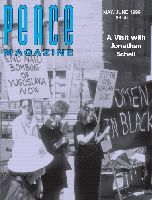
Peace Magazine May-June 1999, page 28. Some rights reserved.
Search for other articles by Janet Nicol here
A memorial museum in Mongolia attempts to redress the violent crimes of the past and informs the outsider of the dark history of a country long hidden in the shadows of its neighbors, the Soviet Union and China. I visited the museum last summer while volunteer teaching in the capital city, Ulan Bator.
The museum is established in a two-storey wooden frame house in the downtown.The museum was opened to the public in 1996. On each of the four walls of the museum's main room are written the names of more than 25,000 Mongolian citizens executed by the state. These names record some of the massive number of state executions committed under the influence of the Soviet Union during under the leadership of Joseph Stalin.
September 10 is a "remembrance day" for the victims of political purges in the 1930s. This opportunity to confront a painful period in their history arose soon after the Soviet Union ended its domination in 1990. Mongolians are traditionally nomadic people, now in transition from a communist to democratic and capitalist system, and it is the scars of the Soviets' 69 years of control that lingers in their memories.
Remembrance Day brings hundreds of local citizens to the main public square of Ulan Bator for a candlelight vigil. The government declared this day "official" in 1996, but people have gathered informally since 1992. As well, a compensation bill for the victims' families was passed by the government in early 1998. Families of the victims have been exonerated and some monetary compensation has been paid.
Included in the executions in Mongolia were over 10,000 Buddhist monks. By the late 1930s, the Buddhist establishment controlled education, health, and the judiciary aspects of Mongolian society. Their income was almost as much as that of the state and in 1935 monks constituted 48 percent of the adult male population. The monks were targeted as part of the ruling party's Soviet-led campaign to rid the country of its main religious institution. Subsequently only one lamasery, Gandan Temple in Ulan Bator, was allowed to exist.
Mongolian government officials accused of being Japanese spies in the 1930s had been included in round-ups. A museum painting showing armed soldiers pulling nomadic tent-dwelling farmers from their traditional felt "ger" tents, informs the viewer of the terror experienced by ordinary citizens.
Recognition Begins the Healing
The Memorial Museum of the Victims of Political Repression, as it is named, also contains archival records, posters, and a reproduction of a prison room. Most of the victims of this period were men. A powerful sculpture shows a woman in a posture of sadness. "Princes descended from Genghis Khan, bureaucrats, and clergymen were executed by army-trained cadres," according to the museum guide sheet. The first purges occurred as early as 1922, based on political in-fighting. The factionalism continued throughout the 1920s and 1930s, culminating in 1937-41 with massive arrests throughout the country. Tens of thousands of people were killed or imprisoned. Mongolians continued to endure repressive political actions from 1950 to 1980, as people were punished with firings, prison, and exile for "anti-party factions," "ultra-nationalistic ideology," and "anti-Soviet ideology." Current Amnesty International reports indicate that Mongolians in Inner Mongolia, an autonomous region of China, are still subject to similar accusations by the Chinese government.
Stories of cruel and arbitrary family loss from this period are still commonly heard. A Mongolian teacher with whom I worked never knew her grandfather, who had been taken away and executed when her father was two years old. Another man reported to an Ulan Bator newspaper: "One day some men came and forced my father out of the ger. He turned to me and said, with tears in his eyes, 'My dear son, now is the time for your Bundkhai to go far away to the sky. Become a good and strong man.' Later, people in green clothes came and confiscated our cattle and property."
Words and money are small comfort for the Mongolian people affected, but the recognition and public display of a long suppressed history mark the beginning of the healing process.
Ms. Nicol, a Vancouver teacher and writer, taught language teachers in Mongolia, sponsored by the Canadian Teachers' Federation and the Free Federation of Mongolian Education and Scientific Workers Union.

Peace Magazine May-June 1999, page 28. Some rights reserved.
Search for other articles by Janet Nicol here